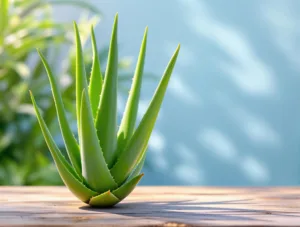The Ultimate Guide to Aloe Vera Gel: Recipes for Moisturizing Skin and Treating Common Issues
Introduction
Aloe vera has been revered for centuries as a natural remedy for skin care, healing, and hydration. Known as the “plant of immortality” by ancient Egyptians, aloe vera gel is packed with vitamins, minerals, enzymes, and amino acids that nourish and repair the skin. Whether you suffer from dryness, acne, sunburn, or irritation, aloe vera offers a gentle yet effective solution.
This comprehensive guide explores the benefits of aloe vera gel for skin health, provides step-by-step recipes for moisturizing treatments, and offers practical solutions for common skin issues. By the end, you’ll have a toolkit of natural, DIY aloe vera remedies to enhance your skincare routine.
1. The Science Behind Aloe Vera’s Skin Benefits
Aloe vera gel, extracted from the inner leaf of the aloe plant, contains over 75 active compounds, including:
- Vitamins (A, C, E, B12) – Promote skin repair and combat free radicals.
- Enzymes (bradykinase, amylase) – Reduce inflammation and exfoliate dead skin cells.
- Minerals (zinc, magnesium, selenium) – Support collagen production and skin elasticity.
- Amino acids – Strengthen skin’s barrier function.
- Polysaccharides (acemannan) – Boost hydration and wound healing.
These components make aloe vera gel a powerhouse for:
- Deep hydration – Acts as a humectant, locking in moisture.
- Soothing irritation – Calms sunburn, eczema, and psoriasis.
- Fighting acne – Contains antibacterial salicylic acid.
- Anti-aging – Stimulates collagen and reduces fine lines.
2. How to Extract Fresh Aloe Vera Gel at Home
Using fresh aloe vera ensures maximum potency. Here’s how to extract it:
Step 1: Choose a Mature Leaf
Select a thick, healthy leaf from an aloe plant (preferably outer leaves).
Step 2: Wash and Trim
Rinse the leaf, then slice off the serrated edges and the base.
Step 3: Extract the Gel
- Slice the leaf open lengthwise.
- Scoop out the clear gel with a spoon.
- Blend for a smoother consistency (optional).
Step 4: Store Properly
Refrigerate in an airtight container for up to a week, or freeze in ice cube trays for long-term use.
3. DIY Aloe Vera Moisturizing Recipes
Recipe 1: Hydrating Aloe Vera Face Gel
Ingredients:
- ¼ cup fresh aloe vera gel
- 1 tsp vegetable glycerin (humectant)
- 2 drops lavender essential oil (calming)
Instructions:
- Mix all ingredients in a bowl.
- Apply a thin layer to clean skin.
- Store in a cool, dark bottle for up to two weeks.
Best for: Dry and sensitive skin.
Recipe 2: Aloe Vera & Honey Overnight Mask
Ingredients:
- 2 tbsp aloe vera gel
- 1 tbsp raw honey (antibacterial)
- 1 tsp jojoba oil (moisturizing)
Instructions:
- Combine ingredients into a paste.
- Apply before bed and rinse in the morning.
Best for: Acne-prone and combination skin.
Recipe 3: Aloe Vera & Coconut Body Butter
Ingredients:
- ½ cup aloe vera gel
- ¼ cup coconut oil (solid)
- 1 tbsp shea butter
Instructions:
- Whip coconut oil and shea butter until fluffy.
- Fold in aloe vera gel.
- Store in a jar and apply as needed.
Best for: Extremely dry skin and eczema.
4. Aloe Vera Treatments for Common Skin Issues
A. Sunburn Relief Spray
Ingredients:
- ½ cup aloe vera gel
- 2 tbsp chamomile tea (cooled)
- 5 drops peppermint oil (cooling effect)
Method:Mix, pour into a spray bottle, and mist over sunburned areas.
B. Acne Spot Treatment
Ingredients:
- 1 tbsp aloe vera gel
- 1 tsp tea tree oil (antiseptic)
Method:Dab onto blemishes and leave overnight.
C. Dark Circle Reducer
Ingredients:
- 1 tbsp aloe vera gel
- 1 tsp cucumber juice
Method:Apply under eyes for 15 minutes, then rinse.
5. Precautions and Tips for Using Aloe Vera
- Patch test first – Some may experience allergies.
- Use pure gel – Avoid store-bought versions with alcohol or additives.
- Combine with other actives carefully – Don’t mix with strong acids (e.g., glycolic acid) without testing.
Conclusion: Why Aloe Vera Deserves a Place in Your Skincare Routine
Aloe vera gel is a versatile, natural solution for hydration, healing, and skin repair. Whether used alone or in DIY recipes, it provides a gentle yet effective alternative to commercial products. By incorporating these treatments into your regimen, you can achieve healthier, glowing skin without harsh chemicals.
Final Tip: For best results, use fresh aloe vera consistently and adjust recipes based on your skin’s needs. Your skin will thank you!
Would you like additional variations for specific skin types or advanced treatments? Let me know how I can expand this guide further!









Add comment